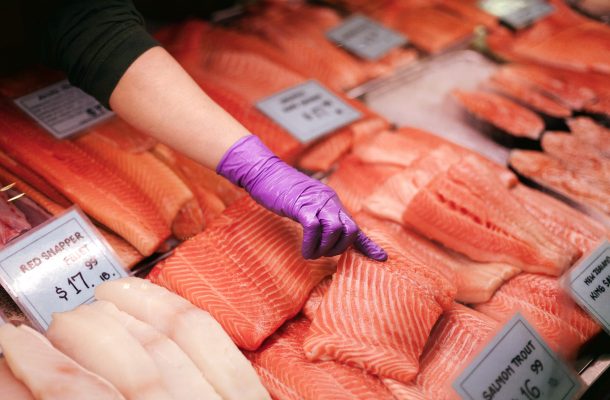Counterpoint by Mark Nicol – Aquaculture: Poaching on the last ecological frontier

The sockeye salmon that wage their incredible annual struggle against nature’s obstacles, to spawn in the pristine upper reaches of Canada’s mighty river network, are perilously diminishing.
Sockeye are a keystone ecological species in the ecosystem. Hundreds of other species, including bear, raptors, seals, otters, and indigenous people are existentially dependent upon the vast quantities of salmon that have been stable within the system for thousands of years.
The Eclipse of Wild Salmon
There is one intrusive factor responsible for the suddenly disappearing salmon. The numbers of those seasoned enough to make the migration to the North Pacific and back feasible, dropped in one area count from 900,000 in the 1970s to 170,000 in 2016. Degradation of freshwater habitat by dams, forestry, agriculture, and invasive species may be partially responsible. But rapid depletion correlates, exactly, with increasing establishment of salmon farms in Canada’s river systems.
Intensive captive populations in these farms act as incubators for parasites, pathogens – sea lice and 9 identified species of debilitating virus, bacteria. These intensive populations of parasites then permeate the river systems, infecting passing wild salmon. Researchers now find high percentages of ready to spawn females dead in the middle and upper reaches of these rivers.
The migration route, of up to 1,600 km, and the marathon swim upstream always test tenacity, existential tenability. But the aquacultural activities of man are proving to be the final straw, for many.
This begs the question: When does a legitimate farmer, hunter, become a poacher?
The legitimate farmer, hunter, takes what is honestly necessary to sustain his family; he holds a humble perspective of his existential rights in relation to the rights and ecological place of other living things. The poacher takes all that he can in order to extend the wealth and domain of his empire, familial, cultural, national, genetic; he holds no regard for the existential rights and ecological vitality of other living things.
This is a new definition of the poacher. The original definition was premised upon anthropocentric egoism, human class egoism, claiming that man had sovereign rights over other life forms, that landed nobility had dominant rights over other socio-economic classes.
The new definition is founded upon ecological premise. We therein regard Life on Earth as the First Estate, man, (the sole super-dominant predator capable of fouling the whole ecosystem), as the Second Estate. The ecological premise of human existential legitimacy is then upheld, when man, individually, collectively, acts as a fair farmer, hunter – not as a devastating, ignominious poacher.
I admire Alexandra Morton, the marine biologist who has waged a losing war with the Canadian government and aquaculture industry for a decade. Morton has undertaken the extensive studies exposing clear connection between salmon farms in British Colombia, the resultant pest problems killing the wild stock.
The Norwegians introduced salmon aquaculture to Canada. They were already aware of the parasite/pathogen problem associated with aquaculture. Meta-tag Norwegian salmon farm on YouTube: Witness the visuals of a hazchem suited employee spraying a cocktail of pesticides, antibiotics into an aquaculture enclosure, direct into a Norwegian fiord. This is the quick fix for the sea lice and pathogen problems. It is the toxic fix, which often makes farmed salmon a highly dangerous food to eat.
The Scandal of Vietnamese Fish Farms
Punch up Vietnam fish farms: See the same frightening process, workers saturating the waters with pesticides, antibiotics. The panga species predominantly farmed there are often laden with dioxins, pcbs, etc. But it is not just the pesticides, antibiotics, accumulating as poisons in the poorly fish and rivers.
Mr. Min is the fourth richest man in Vietnam, with 350 aquaculture ponds containing 100 million panga. He has 8 processing plants, 1,000 piece workers filleting, polyphosphate processing fish for maximum weight, freezing, then export to 30 countries. It is nauseating to look at the life conditions for these sad creatures. They live in waters foetid, writhing with their own numbers and faeces. 3 tonnes of feed pellets are dumped into each pond, twice daily, the waters immediately thrashing with ravenous, desperate life.
The pellets contain excessive fat, protein. This generates double the normal growth rate in the fish, further accumulation of toxins in the excess fatty tissue. This is the generic story, world over, with aquaculture. Wild salmon contain 5 – 7% body fat, farmed salmon 14 – 34%. The flesh of wild salmon is red because the species work their muscles hard in the open sea and rivers. Penned salmon flesh is not red, it is often dyed to fake the appearance of healthy tissue.
The global narrative of the aquaculture industry is dominated by the vastly uneven contest between vested producers, economies, lobbies, and the marginalized scientific, environmentalist critics. Global aquaculture is a US $250 billion per year industry, generating 82 million tonnes of produce in 2018, growing at more than 3% per year. China is by far the largest producer, outputting more than half of that total.
Alexandra Morton, Dr. Kristi Miller, and Victoria Bohn are Canadian scientists who have been methodically silenced or lost their jobs with Fisheries and Oceans Canada. Bill 37, aimed specifically at these researchers, was placed before Canada’s legislature by Minister of Agriculture Don McCrae.
This law would have made it illegal for anyone to publish material reporting on Canada’s salmon aquaculture industry, a crime punishable by 2 years imprisonment and a $45,000 fine. The proposed bill was found to be unconstitutional. The environmental activist, Kurt Oddekalv, similarly exposing toxic practices in Norwegian salmon farming, has not suffered that level of State intimidation.
The dominant agents in the aquaculture story are Mr. Min and co. in Vietnam, the MOWI, Cermaq, Grieg companies in Canada – Norway, Egypt, Bangladesh, Indonesia, India, and the massive, unchecked operation in China. Most large countries are investing in aquacultural production, because free ranging fish populations in the world’s oceans, rivers, are depleted from over exploitation. Natural stocks are insufficient to meet global consumer demand.
The Global Aquaculture Alliance
Step in The Global Aquaculture Alliance. Punch that up and you’ll get the hard sell: “Global Aquaculture Alliance – The Future of Food. To meet the world’s seafood needs, aquaculture production will need to increase by 46.4 million tons (per year).” “The Global Aquaculture Challenge is an imperative to our viability on this planet.”
This dismal ideological gruel is mirrored by a purportedly innocent, humanitarian organization: “The Food and Agriculture Organization of the United Nations works to achieve food security for all … The fisheries and aquaculture sector contributes significantly … especially in some of the world’s most food-limited regions.”
Bottom line? The devastating avarice of aquacultural entrepreneurs, corporations, is underwritten by ongoing growth in human population. The UN applies no honest agenda to reverse this trend. Every profligate agency in the world is glad to see global population keep growing, because more people equals more demand, more profit.
The Global Aquaculture Alliance may be attempting to detoxify production practices through certification measures. But penned animals, of any sort, will never be as biologically healthy as free range animals, can never, ever live healthy lives.
China is responsible for 62% of global aquaculture production, 15% of global fish catches, 20%, by number, of the dams that obstruct free river and stream flows. It is the monumental, unrelenting devastations wrought by Sinese waterway industry, which pose the glaring threat to life on Earth. Most large nations are complicit with the same process. But China applies ruthless extension, indifference to the carnage.
The Galapagos Islands waters, sovereign to Ecuador, are legislated as an international marine reserve. The region is a hot-spot breeding, feeding site for innumerable marine species, from whales down to plankton. For several years the Chinese have saturated the perimeter with over 250 huge fishing vessels, including illegal link-up freezer ships.
Such a ‘reefer’, the Fu Yuan Fu, was intercepted in the Marine Reserve in 2017. It contained 300 tonnes of mostly sharks, including protected species. Chinese vessels use night lights to lure tons of squid into captivity, whilst Ecuador’s political silence was bought with $4.5 billion worth of infrastructure loans.
China’s distant-water fishing fleet is the world’s largest, at 17,000 vessels. This includes long-line boats, (hooked lines up to 80km long); purse seine vessels, (nets up to 2,000m long, 200m in depth, drawn in with the revolutionary Power Block pulleys commended by the UNFAO).
Of 87,000 dams constructed in China, those blocking the Mekong river flows into Myanmar, Vietnam, Thailand, Laos, Cambodia, the Brahmaputra flows into India are not just servicing irrigation, flood mitigation designs. This is the geoeconomic face of aquacultural war. Factor in 20 tonnes of Australian lobster recently left to perish at Shanghai’s airport, capital victims of Sinese trade bullying.
What organisms will out-survive all aqua-cultivated, earthly species, man included?
Our sulfur eating friends.
Better eat up on toxic seafood, and feed the future.
Mark Nicol is based in Adelaide and has written four environmentalist books offering his perspectives on cosmology, human history and economic, political, religious, and educational institutions.










